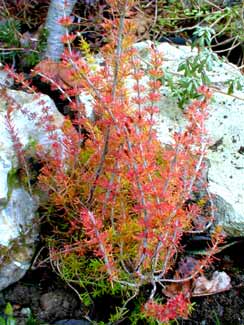
'Golden Sport' Bell Heather;
aka, Golden Twisted Heath
The heather was blooming, the meadows were mawn,
Our lads gaed a-hunting ae day at the dawn,
O'er moors & o'er mosses & mony a glen,
At length they discover'd a bonie moor-hen.
I rede you, beware at the hunting, young men,
I rede you, beware at the hunting, young men;
Take some on the wing, & some as they spring,
But cannily steal on a bonie moor-hen.
Sweet-brushing the dew from the brown heather bells
Her colours betray'd her on yon mossy fells;
Her plumage outlustr'd the pride o' the spring
And O! as she wanton'd sae gay on the wing.
Robert Burns
1759-1796
1759-1796
Bell Heathers (or one word, Bellheather) are common throughout Europe from Norway to Great Britain to Portugal. They grow in seasonally dry bogs at high elevations, dry raised humps in lowland bogs, & along the dryish edges of mooreland heaths.
The bright flowers of Bellheathers have a much greater impact than for the common purple heather (Caluna vulgaris), having as they do spikes of dangling blooms in deep shades of magenta to purply-pink, vs common heathers' usual small purple flowers at limb tips.
Bellheathers are sometimes found growing wild along with common purple heathers, but is not a strong competitor & can become scraggly-looking amidst the more aggressive subshrubs, trying as it does to reach beyond its usual short stature for its share of light & becoming thinner over time.
It looks better — rounded to nearly prostrate — when it has no competitor in a location near the dripline of larger shrubs, where it gets plenty of sun but is protected from winter winds or too awfully strong a summer sun.
The hybrid bellheather Erica cinerea x darleyensis 'Golden Sport' has amethyst flowers in summer & early autumn, potentially from July to November, being one of the longest flowering Erica cultivars. It was first introduced from Germany as a sport among nursery stocks. Smaller than the species, it is often only six or eight inches tall, & a foot wide.
In winter the dried blooms cast thousands of seeds, but few of these seeds will ever germinate. Robert Burns sang of "dew from the brown heather bells," for they turn to small brown bells such as can be left for the small decorative value they have through winter unto early spring. But it is probably better to trim the spent flowers from 'Golden Sport' in order to better display this variety's unique winter-golden foliage. Furthermore, trimming to the base of the flower spike is often all the pruning the little shrub will require, to insure fresh new growth the following spring.
The needle-like leaves in the wild are normally colored in the range of dark green to grey; the duller-leafed forms are called Grey Heather or Crossleaf Heather, though they are the same species. The leaves are arranged in threes in a whorl, projecting an overall fuzz-ball look.
For 'Golden Sport,' however, the leaf color is much more dramatic. The evergreen leaves begin yellow to yellow-green for spring & summer, then in autumn turn a brilliant shining gold & magenta, holding this beautiful coloration right through to the end of winter. The photo above shows a young specimen in February.
In climates much colder than ours Bellheathers will require mulching with leafmold or peat to protect the root from severe freeze. Just before spring, whatever is left of the shrublet will need to be cut back severely due to winter damage, but will soon return in spring. In our moderate climate, however, they need only a little sheering to insure plenty of colorful new growth, but are unphased by our winters.
It can tolerate & may even require a tiny bit of shade in hot regions or at the height of summer, but does best on Puget Sound in full morning or full afternoon sun. Dry winds are their enemy especially when getting started; placement at a sunny dripline of a larger shrub will protect it.
Bellheathers can sometimes be a little difficult to get started, but hardy once they make it through their first year or two. New plantings for their first year or so should not experience even transient droughtiness or dry winds, or they may suddenly die, but once well rooted in its location it will become increasingly impervious to injury from varying weather conditions. Persistent moisture but with perfect drainage is always ideal, but once established, bellheathers are more drought tolerant than common purple heather.
Alkalinity will kill this plant. It needs an organically rich acidic soil. It does not need nitrogen fertilizer, but annual small amounts of bone meal or kelp, or a topcoating of leafmold or peat, can be beneficial, or at strongest a low-nitrogen evergreen fertilizer, half as much as recommended for most evergreens. With any kind of heather, if it appears to be in prime condition, do not fertilize with anything for that year.
If allowed to "go wild" without annual pruning, the brilliance of 'Golden Sport's' winter color will diminish year by year, but autumn or late-winter pruning encourages new growth which will for the following autumn provide the brightest colors. Plus an annual pruning keeps the mini-shrub looking like a compact little fuzzball instead of spreading outward in a lanky manner.
Its colorful combination of summer & early autumn blooms & its autumn & winter golds & red leaves make this tiny evergreen truly a year-round beauty.